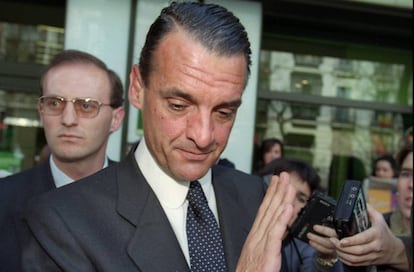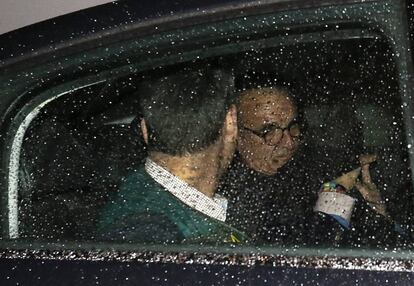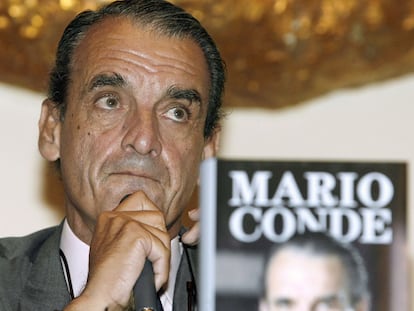Mario Conde: The brief but brilliant career of a failed banker
Thanks to his meteoric rise, the disgraced former Banesto chief was once profiled for a career in politics


There is something of the inevitable about Mario Conde’s latest downfall. The twice-jailed former chairman of Banesto embezzled a lot of money from the bank he ran, allegedly squirreling it away in Swiss bank accounts (and who knows where else), and then supposedly funneling it back to Spain in small amounts over the last year.
On Monday he was arrested on suspicion of laundering those funds back into Spain, an alleged amount as high as €14 million. His children, Alejandra and Mario, and his son-in-law, Fernando Guasch, are among the seven other people who have been detained, on suspicion of helping Conde create a web of companies – at least three in Spain and another dozen or so abroad – that were used to transfer the money.
Mario Conde came to represent the get-rich-quick culture that characterized Spain in the late 1980s
It’s more than two decades since Conde’s illegal activities at Banesto were uncovered, but it took him just six years to rise so high and fall so far. In the meantime, aside from his jail terms, he has unsuccessfully run for public office, supposedly to change the system he has criticized so vocally, and he has remarried and moved into a home in a tiny village in Galicia called Chaguazoso, where he lives when not spending time at his Madrid residence or country houses in Andalusia. He’s also lost friends as easily as he made them, appeared countless times on television, and even financed his own biopic. You could say he got rich too soon and too quick.
In fact, Mario Conde came to represent the get-rich-quick culture that characterized Spain in the late 1980s, using all kinds of financial shenanigans to take advantage of the rapid economic growth that came with Spain’s entry into the European Union. The one-time solicitor general made his first fortune with friend Juan Abelló in 1987 through the sale of a pharmaceutical company for €350 million, using the money to buy their way into under-performing Banesto. That same year, when Banco Bilbao launched a buyout bid for Banesto (Spain’s banks had been told they needed to consolidate), Conde saw his opportunity, siding with some of Banesto’s older shareholders to resist the buyout, in the process forcing out the bank’s chairman. Bilbao’s takeover bid failed, and Conde, the man of the hour, was installed as chief, with Abello his vice chairman, although the two would soon fall out.

Conde then surrounded himself with men he could trust, as well as signing up a number of senior figures from the ruling Spanish Socialist Party (PSOE) to cover his back, and set about running Banesto as though it were his personal fiefdom. When the bank joined the top flight of Spanish lenders, Conde’s star really began to shine: he was invited to the top parties, was on first name terms with King Juan Carlos, and was even awarded an honorary doctorate by Madrid’s Complutense University. He also began profiling himself as the great white hope of a Spanish right still struggling to reinvent itself as a credible political force, and which would lose two elections under José María Aznar in 1989 and 1993. In short, here was a man who had just about everything anybody could want before the age of 40, a Spanish success symbol if ever there was one.
But on the morning of December 28, 1993, everything was to change. The Bank of Spain had discovered a €3.8 billion shortfall in Banesto’s books. The central bank had warned Conde on several occasions about Banesto’s precarious situation, to no avail. Banesto, like other Spanish lenders, was struggling to match Santander’s performance, and had also run into serious difficulties after the initial public offering of Banesto’s industrial arm, at the same time as a global economic downturn took effect, sparked by the first Gulf War in 1991.
On the morning of December 28, 1993, everything was to change. The Bank of Spain had discovered a €3.8 billion shortfall in Banesto’s books
Conde’s response to Banesto’s problems was to try to raise money through a capital increase of €781 million through J. P. Morgan. In April 1994, Banesto was sold to Santander at auction for €1.9 billion.
After this, Conde’s fall from grace came fast: his former friends on the political right abandoned him and with the economy in recession, the media portrayed him as symbol of all that was wrong with Spain’s get-rich-quick culture. His response was to accuse the establishment, “the system” of conspiring against him. In the meantime, he was the subject of a Congressional investigation. In 1997 he was sentenced to six years in jail for embezzlement, but was out on parole in less than two years.
In 2000, shortly after announcing he was running for prime minister in the elections of that year (presumably in the hope of gaining immunity from prosecution by a lower court), the High Court sentenced him to 10 years on the same grounds, with the Supreme Court adding another 10.
He would serve half his sentence, saying when he left a Madrid jail: “I’m happy because fortunately, justice has been done.” He then reinvented himself as a television pundit, and once again, and unsuccessfully, ran for office last year. In the meantime, it would appear that he was quietly repatriating the money he had embezzled from Banesto back from Switzerland to Spain, with the help of his two children.
Sign up for our newsletter!
EL PAÍS English Edition is launching a weekly newsletter. Sign up today to receive a selection of our best stories in your inbox every Saturday morning. For full details about how to subscribe, click here.
English version by Nick Lyne.
Tu suscripción se está usando en otro dispositivo
¿Quieres añadir otro usuario a tu suscripción?
Si continúas leyendo en este dispositivo, no se podrá leer en el otro.
FlechaTu suscripción se está usando en otro dispositivo y solo puedes acceder a EL PAÍS desde un dispositivo a la vez.
Si quieres compartir tu cuenta, cambia tu suscripción a la modalidad Premium, así podrás añadir otro usuario. Cada uno accederá con su propia cuenta de email, lo que os permitirá personalizar vuestra experiencia en EL PAÍS.
¿Tienes una suscripción de empresa? Accede aquí para contratar más cuentas.
En el caso de no saber quién está usando tu cuenta, te recomendamos cambiar tu contraseña aquí.
Si decides continuar compartiendo tu cuenta, este mensaje se mostrará en tu dispositivo y en el de la otra persona que está usando tu cuenta de forma indefinida, afectando a tu experiencia de lectura. Puedes consultar aquí los términos y condiciones de la suscripción digital.
More information
Últimas noticias
Maduro pleads not guilty before the federal court in New York: ‘I am still the president of Venezuela’
A new test can detect Alzheimer’s from a finger prick
UN team enters Sudanese city of El Fasher after paramilitary massacre: ‘It’s like a ghost town’
A recipe for resistance: Indigenous peoples politicize their struggles from the kitchen
Most viewed
- Gilles Lipovetsky: ‘If you want to live better and fall in love, take Prozac, don’t look to philosophy’
- Alain Aspect, Nobel laureate in physics: ‘Einstein was so smart that he would have had to recognize quantum entanglement’
- Alvin Hellerstein, a 92-year-old judge appointed by Bill Clinton, to preside over Maduro’s trial in New York
- Why oil has been at the center of Venezuela-US conflicts for decades
- Cuba confirms death of 32 of its citizens in the US attack against Venezuela










































